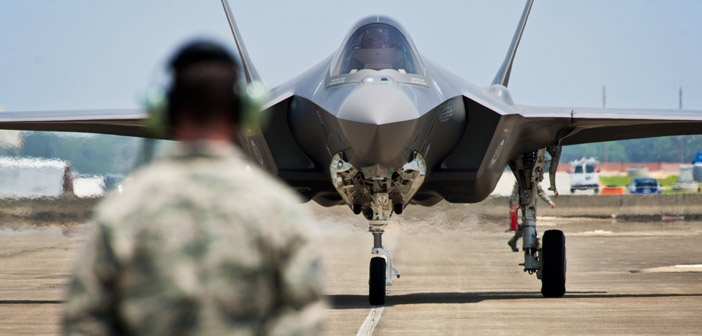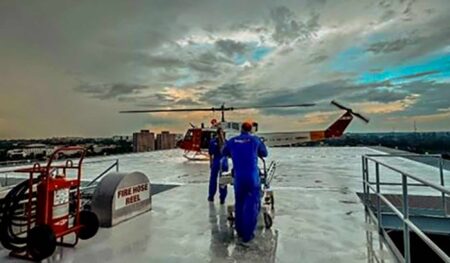The 33 FW provided air dominance with the F-15 Eagle for over 30 years, but their mission changed in early 2009. The Nomads were tapped to stand up the first F-35 Lightning II wing in the world.
EGLIN AIR FORCE BASE, Fla. — (Editor’s Note: This is the final article in the Sharpening the Spear series)
Since the 33rd Fighter Wing’s existence, even before the Air Force’s, the Nomads were among the best in the sky. They earned respect from peers and foes alike while defending the homeland’s shores, securing North Africa and eliminating Axis Powers in Europe during WWII.
The skills they displayed in the air earned the nickname “MiG Killers” during the Vietnam War, a legacy that rang true throughout OPERATION DESERT STORM. Being the best, under any circumstances and in any location made them the ideal candidate to construct the future of Air Force aviation.
The 33 FW provided air dominance with the F-15 Eagle for over 30 years, but their mission changed in early 2009. The Nomads were tapped to stand up the first F-35 Lightning II wing in the world.
The transition to the new platform was not flawless, but the unit persevered through the preparations.
This new aircraft required a different mindset and mission set for the wing; transitioning from combat to training. Instead of wielding the spear in war, they would sharpen it and prepare pilots for the operational Air Force. This change was coupled with a change in major command, from Air Combat Command to Air Education and Training Command. The world’s first F-35 wing was now a member of the U.S. Air Force’s first command.
The F-35 Lightning II is shared between a dozen countries with separate variants used by the U.S. Air Force, Navy and Marine Corps. When the wing started the joint venture, it adopted the Marine Corps’ F-35B squadron, VMFAT-501, in 2010, and the Navy’s F-35C squadron, VFA-101, in late 2013.

This change added new dynamics to the wing’s transition. It would later become apparent how more than 70 years of aviation had changed the language of pilots between services. Together, the services adapted to the new joint environment, helping to effectively share information across the enterprise. The same interoperability is evident today in the tactics, training and procedures used across the variants. This communication was possible, largely in part to the 70 percent commonality shared between the models.
Another addition to the wing’s workload was the inclusion of the Air Force’s only Air Battle Manager school house. The 337th Air Control Squadron at Tyndall Air Force Base, is home to the undergraduate course which teaches students six fundamental functions that impact air warfare: orient shooters, pair shooters, solve problems, speed decisions, bring order and up-channel assessments.
Similarly, the Nomads absorbed two critical intelligence missions. The F-35 Intelligence Formal Training Unit here is the gateway for intelligence personnel who will work with the aircraft. The Air Force Special Operation Forces IFTU prepares enlisted and commissioned intelligence communities to be stationed with any Air Force special operations units. Both organizations teach students how to provide a threat picture and analysis, which in turn enables weapons systems to safely execute their mission.
Following the delivery of the first F-35, “AF-9” July 14, 2011, the 33 FW’s mission transitioned from preparing for the world’s most advanced aircraft to training the pilots who implement it.
“We’ve been in a growth mindset for the last few years,” said Lt. Col. Matt Renbarger, 2014 58th Fighter Squadron commander. “We’ve been focused on adapting our training levels to the availability of aircraft as a growing squadron. It’s been exciting to see this mission develop, but we’re more excited to dial-in all of our attention to training our team.”
The wing’s final F-35A, the Air Force specific variant, arrived May 28, 2014. With the Nomads at full strength, they set their goal to demonstrating the jets potential and achieving Initial Operational Capability.
“The arrival of AF-45 is an incredible milestone for the Air Force,” said Col. Todd Canterbury, former 33 FW commander. “The men and women here are establishing the foundation for all F-35A training operations. Having our full end-strength grants our pilots and maintainers more flexibility in training, and that flexibility lets us advance the F-35 program at a faster rate than ever before.”
The milestone was short lived as it was quickly overshadowed by a blow to the F-35 program. Environmental Impact Surveys done in the base ’s local area led to a lawsuit. The 33FW was originally slotted to have 107 F-35s assigned to the unit. As a result of the investigation, that number was cut down by two-thirds of the original number.
The Marine Corps’ F-35B unit left Eglin July 11, 2014, and relocated to Marine Corps Air Station Beufort, South Carolina. Their departure and limitations set on the number of local aircraft permitted on station led to the 33 FW having the capability to house four fighter squadrons, with only two present.
Through that drastic change in aircraft and manning, the mission persisted with the intent of displaying the aircraft’s true capabilities by consistently achieving enterprise milestones.
Just over two years later, Aug. 2, 2016, the wing’s hard work paid off when the F-35A was declared ‘combat ready.’
“The combat ready F-35A is the latest fifth-generation fighter aircraft in the Air Force’s inventory and provides our nation air dominance in any environment. (It) brings an unprecedented combination of lethality, survivability, and adaptability to joint and combined operations, and is ready to deploy and strike well-defended targets anywhere on Earth,” said General David Goldfein, Air Force Chief of Staff.
More so than ever, the wing’s pilot training mission shaped the foundation for fifth-gen tactics and the future of air superiority.
Chief Master Sgt. Yasmeen Wilson, 33 FW command chief, explained that although the wing doesn’t execute combat operations, the work here remains significant to the war fighter.
“Our combat focus should be making sure that people are prepared for that environment when they encounter it, regardless of if they are air battle managers, intelligence personnel or part of the F-35 community,” Wilson said. “If we are not thinking about how people will employ this aircraft downrange, then we are not setting them up for success.”
The foundation for the F-35 was built upon the success of the Nomads, which was made possible through the integration of personnel from some of the Air Force’s legacy aircraft. Pilots and maintainers from the F-16, F-15 and A-10 communities were selected to transition to the Lightning II to use their depth of knowledge in creating the backbone of the program.
“A foundation is critical for a house,” Wilson said. “The foundation may not be as visible, but without that foundation everything else crumbles. We are a foundational part of the F-35 program. Having knowledge and experience from those communities cumulatively working on this program had a synergistic effect.”
Wilson said the future is just as important as our past. Since the transition from ACC to AETC, the Nomads never lost their warrior ethos. The shared mindset led to the success the F-35 program has achieved to date, and she believes it will continue to contribute to the wing’s advancement.
“I’m proud to serve in a unit that is so prestigious, knowing that we are going to keep doing such great things,” Wilson said. “Being a part of such a great team makes me walk a little taller, with my head higher, because I know I am a part of something that is greater than just me.”
The Nomads have answered their call to arms since their beginnings in WWII. They have commanded the skies while growing generations of the world’s most elite aviators. There may be challenges on the horizon, but they will be confronted by the same vigor and determination as the past. With flexibility being the key to air power, the 33 FW stands ever ready to meet the needs of the Air Force.
PHOTO (TOP): F-35A Lightning II joint strike fighter crew chief, Tech. Sgt. Brian West, watches his aircraft approach for the first time at Eglin Air Force Base, Fla., July 14. (U.S. Air Force photos/Samuel King Jr.)
Story by Staff Sgt. Peter Thompson, 33rd Fighter Wing










